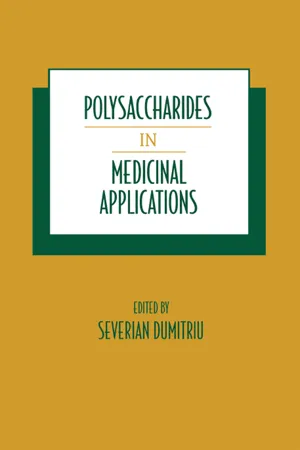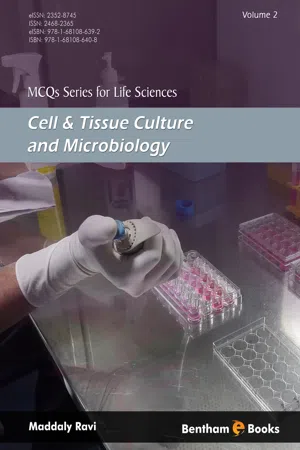Biological Sciences
Capsules
Capsules are small, membrane-bound structures found in cells that contain various substances such as nutrients, enzymes, or genetic material. They play a role in protecting and transporting these substances within the cell. In bacteria, capsules are also involved in protecting the cell from the host's immune system and in forming biofilms.
Written by Perlego with AI-assistance
4 Key excerpts on "Capsules"
- eBook - ePub
- Vincent A. Fischetti, Richard P. Novick, Joseph J. Ferretti, Daniel A. Portnoy, Mirian Braunstein, Julian I. Rood, Vincent A. Fischetti, Richard P. Novick, Joseph J. Ferretti, Daniel A. Portnoy, Mirian Braunstein, Julian I. Rood(Authors)
- 2019(Publication Date)
- ASM Press(Publisher)
63 ).Since the major component of the capsule is water, it is not easy to preserve such polymeric polysaccharides in a natural state for electron microscopic observation. A method of choice is to introduce a kind of a scaffold within the capsule layers to prevent collapsing through chemical fixation and dehydration. As has been explicitly described several times in this chapter, fully hydrated and vitrified samples give the best close-to-nature view of the dimensions of a given bacterial capsule. Nevertheless, the incorporation of lysine as a positively charged component, which reacts by van der Waals forces with the capsule layer negative charges from the polysaccharides, provides a reasonable method to preserve the capsular ultrastructure in ultrathin sections. For a rapid visualization of Capsules in a TEM, the capsule can be stained with cationic-coated gold nanoparticles (lysine-coated gold nanoparticles). For S. pneumoniae it has been demonstrated that fixation with 1% formaldehyde further supports the capsule structure, whereas fixation with glutaraldehyde results in loss of the capsule structure (64 ). The bound gold particles around the bacterium show indirectly the presence of the capsule and its dimensions (see Fig. 4 ). For ultrathin sections, bacteria are incubated with lysine acetate. In the second step the bound lysine reacts with ruthenium red, which subsequently is precipitated by osmium tetroxide. The precipitates formed in the capsular layers give reasonable support for preservation of the Capsules in various Gram-positive bacteria, which allow for measurements of capsule dimensions or for imaging of the in vivo expressed Capsules in blood or organs (52 ) (see Fig. 5 - eBook - ePub
- Severian Dumitriu(Author)
- 2017(Publication Date)
- CRC Press(Publisher)
6 ]. Several factors, including the high mortality and morbidity rates endemic and epidemic diseases, and expanding incidence of antibiotic-resistance strains, have emphasized the importance of prevention and control of encapsulated bacterial diseases.Capsular polysaccharides are cell-surface polymers consisting of oligosaccharide repeating units. These PSs are negatively charged and bind to quaternary ammonium detergent (Cetavlon), allowing their isolation from the cells by differential ethanol precipitation and purification by organic solvent extraction and ultracentrifugation. A diagram of isolation and purification of bacterial polysaccharides, e.g., pneumococcal PS, is shown in Fig. 1 [7 , 8 , 9 ].Most adult animal sera contain antibodies against PS antigens of various pathogenic bacteria. Antibodies to pathogens such as meningococcal group A, B, C; Haemophilus influenzae type b; and pneumococcal type 3 were detected in animals as they grew or in human adults who had had no possible contact with these organisms [10 ]. The possible antigenic sources of these serum protective antibodies have been identified and found to be derived from cross-reactive antigens among intestinal and pharyngeal bacteria 10 , 11 , 12 ]. Several nonpathogenic bacteria produce polysaccharides with identical or similar chemical structures to those of pathogenic organisms (Table 1 ). These cross-reactive PSs are closely related to the natural immunity that the infants obtained during early life and development.II. PROTECTIVE IMMUNITY AND ANTIBODY RESPONSECell-surface components of the encapsulated bacteria are involved in interactions with the immune system. Capsular PSs are responsible for the stimulation of the immune response and serve as virulence factors of the bacteria. These PSs are highly polar and hydrophilic and interfere with cell-to-cell interactions with phagocytes. The ability of host phagocytes to ingest and kill invading organisms requires coating of the bacteria by antibodies and complement. This process, called opsonization, results in phagocytosis, which destroys invading bacteria. Antibodies bound to Capsules may act as bacterial cell-to-phagocytic cell ligands or as complement activator. In pneumococci, specific antibodies can act as opsonins by attaching directly to IgG Fc receptors of the phagocyte surface. Opsonization may also occur by type-specific antibodies, acting in accord with the classical complement pathway, or by adhering immunoglobulin molecules nonspecifically through the alternative pathway. Anticapsular antibodies increase the rate of clearance of pneumococci, primarily through the activation of the classical complement pathway [13 , 14 ]. Figure 2 - Titus A. M. Msagati(Author)
- 2012(Publication Date)
- Wiley-Blackwell(Publisher)
The principle behind microencapsulation is based on the creation of the microcavity in the capsule by a polymer material used for encapsulation. The formed microcavity governs and controls the mechanisms involving the interactions between the core and the environment surrounding the core. Microencapsulation is needed in food industries to incorporate flavours and colours as well as additives such as antioxidants, nutraceuticals, probiotics, prebiotics and synbiotics. The process of microencapsulation takes into consideration a number of factors such as the stability of the bioactive ingredients and aims to discourage any adverse interactions within the shell during the processing or storage, until the active ingredient is released within the consumer's gut. Core materials are therefore protected from any detrimental conditions that would result in the deterioration of its integrity.Due to differences in terms of the shape, structures and configuration of core materials, microCapsules are designed with different shapes. Variations include encapsulating multicores, multiwalls, smooth and regular shapes and irregular shapes (Figure 21.2 ).Generally, food-grade microCapsules are designed to either be permeable (especially when intended to be used for controlled release); semi-permeable (where they are selectively permeable to some specific molecules and effectively impermeable to the external environment); or impermeable (where rupturing of the shell is required to release the core).On the other hand, bioencapsulation deals mainly with the encapsulation of cells, tissues and active biomolecules using semi-permeable membranes. Biomaterials are safely enclosed and protected from any external factors that may result in potential damage (de Vos et al.- eBook - ePub
- Maddaly Ravi(Author)
- 2018(Publication Date)
- Bentham Science Publishers(Publisher)
Microbial Structure and Function Maddaly Ravi- The dense coat of bacteria, if present is called
- Cell wall
- Capsule
- Plasma membrane
- Envelop
- Loosely associated external bacterial coat is called
- Cell wall
- Capsule
- Slime layer
- Envelop
- Bacterial Capsules and slime layers are composed of
- Proteins and polysaccharides
- Only proteins
- Only polysaccharides
- Neither proteins nor polysaccharides
- Bacterial strains that are referred to as “smooth” contain
- Capsules
- Cell walls
- Envelop
- Slime layer
- Bacterial strains that are referred to as “smooth” do not contain
- Capsules
- Cell walls
- Envelop
- Slime layer
- Capsules function for
- Staining bacteria
- Increasing the pathogenicity of bacteria
- Identifying bacteria
- Culturing bacteria
- Cell walls of bacteria are also known as
- Capsules
- Membrane
- Envelop
- Slime layer
- The most abundant bacterial cell wall component is
- Peptidoglycan
- Dextrose
- Starch
- Cellulose
- The number of peptidoglycan layers that Gram-positive bacteria have is
- 10-50
- 5-10
- 1-5
- 4
- The number of peptidoglycan layers that Gram-negative bacteria have is
- 1-4
- 2-10
- 1-2
- 5-10
- The shape of Gram-positive bacteria is
- Rigid
- Flexible
- Can be rigid or flexible
- No definite shape
- The shape of Gram-negative bacteria is
- Rigid
- Flexible
- Can be rigid or flexible
- No definite shape
- The Gram-positive bacteria are usually
- Rods only
- Cocci only
- Rods and cocci
- Spirals
- The Gram-negative bacteria are usually
- Rods
- Rods and cocci
- Rods, cocci and spirals
- Rods, cocci, spirals and pleomorphic
- Spore formation occurs in
- Gram-positive bacteria
- Gram-negative bacteria
- Both Gram-positive and –negative bacteria
- The Gram-staining does not matter
- Spore formation does not commonly occur in
- Gram-positive bacteria
- Gram-negative bacteria
- Both Gram-positive and –negative bacteria
- The Gram-staining does not matter
- Penicillin has a greater inhibitory potential on
- Gram-positive bacteria
- Gram-negative bacteria
- Both Gram-positive and –negative bacteria
- The Gram-staining does not matter
Index pages curate the most relevant extracts from our library of academic textbooks. They’ve been created using an in-house natural language model (NLM), each adding context and meaning to key research topics.
Explore more topic indexes
Explore more topic indexes
1 of 6
Explore more topic indexes
1 of 4



